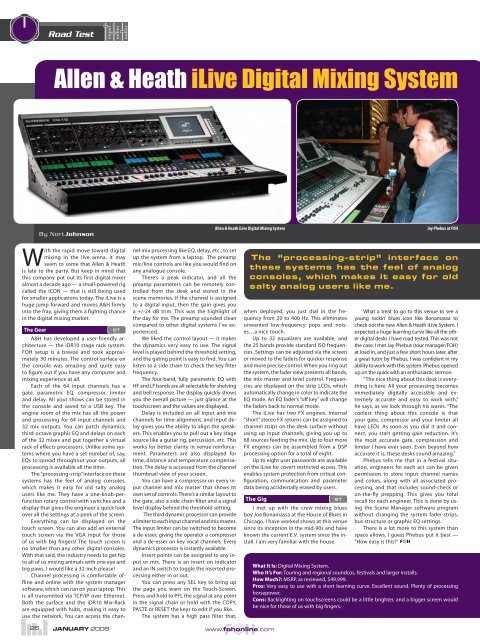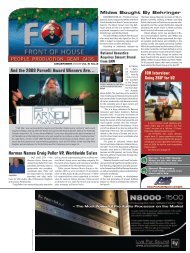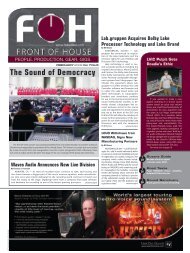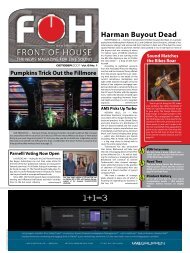X2's “Audio As Data” Approach Addresses Wireless ... - FOH Online
X2's “Audio As Data” Approach Addresses Wireless ... - FOH Online
X2's “Audio As Data” Approach Addresses Wireless ... - FOH Online
You also want an ePaper? Increase the reach of your titles
YUMPU automatically turns print PDFs into web optimized ePapers that Google loves.
With the rapid move toward digital<br />
mixing in the live arena, it may<br />
seem to some that Allen & Heath<br />
is late to the party. But keep in mind that<br />
this company put out its first digital mixer<br />
almost a decade ago — a small-powered rig<br />
called the ICON — that is still being used<br />
for smaller applications today. The iLive is a<br />
huge jump forward and moves A&H firmly<br />
into the fray, giving them a fighting chance<br />
in the digital mixing market.<br />
The Gear RT<br />
A&H has developed a user-friendly architecture<br />
— the iDR10 stage rack system.<br />
<strong>FOH</strong> setup is a breeze and took approximately<br />
30 minutes. The control surface on<br />
the console was amazing and quite easy<br />
to figure out if you have any computer and<br />
mixing experience at all.<br />
Each of the 64 input channels has a<br />
gate, parametric EQ, compressor, limiter<br />
and delay. All your shows can be stored in<br />
the console and saved to a USB key. The<br />
engine room of the mix has all the power<br />
and processing for 64 input channels and<br />
32 mix outputs. You can patch dynamics,<br />
third-octave graphic EQ and delays on each<br />
of the 32 mixes and put together a virtual<br />
rack of effects processors. Unlike some systems<br />
where you have a set number of, say,<br />
EQs to spread throughout your outputs, all<br />
processing is available all the time.<br />
The “processing-strip” interface on these<br />
systems has the feel of analog consoles,<br />
which makes it easy for old salty analog<br />
users like me. They have a one-knob-perfunction<br />
rotary control with switches and a<br />
display that gives the engineer a quick look<br />
over all the settings at a peek of the screen.<br />
Everything can be displayed on the<br />
touch screen. You can also add an external<br />
touch screen via the VGA input for those<br />
of us with big fingers! The touch screen is<br />
no smaller than any other digital consoles.<br />
With that said, the industry needs to get hip<br />
to all of us mixing animals with one eye and<br />
big paws. I would like a 32-inch please!<br />
Channel processing is comfortable offline<br />
and online with the system manager<br />
software, which can run on your laptop. This<br />
is all transmitted via TCP/IP over Ethernet.<br />
Both the surface and the iDR10 Mix-Rack<br />
are equipped with hubs, making it easy to<br />
use the network. You can access the chan-<br />
26<br />
Road Test<br />
Allen & Heath iLive Digital Mixing System<br />
By NortJohnson<br />
nel mix processing like EQ, delay, etc., to set<br />
up the system from a laptop. The preamp<br />
mic/line controls are like you would find on<br />
any analogue console.<br />
There’s a peak indicator, and all the<br />
preamp parameters can be remotely controlled<br />
from the desk and stored in the<br />
scene memories. If the channel is assigned<br />
to a digital input, then the gain gives you<br />
a +/-24 dB trim. This was the highlight of<br />
the day for me. The preamp sounded clean<br />
compared to other digital systems I've experienced.<br />
We liked the control layout — it makes<br />
the dynamics very easy to use. The signal<br />
level is played behind the threshold setting,<br />
and the gating point is easy to find. You can<br />
listen to a side chain to check the key filter<br />
frequency.<br />
The four-band, fully parametric EQ with<br />
HF and LF bands are all selectable for shelving<br />
and bell response. The display quickly shows<br />
you the overall picture — just glance at the<br />
touchscreen and the values are displayed.<br />
Delay is included on all input and mix<br />
channels for time-alignment, and input delay<br />
gives you the ability to align the speakers.<br />
This enables you to pull out a key stage<br />
source like a guitar rig, percussion, etc. This<br />
works for better clarity in venue reinforcement.<br />
Parameters are also displayed for<br />
time, distance and temperature compensation.<br />
The delay is accessed from the channel<br />
thumbnail view of your screen.<br />
You can have a compressor on every input<br />
channel and mix master that shows its<br />
own set of controls. There’s a similar layout to<br />
the gate, also a side chain filter and a signal<br />
level display behind the threshold setting.<br />
The third dynamic processor can provide<br />
a limiter to each input channel and mix master.<br />
The input limiter can be switched to become<br />
a de-esser, giving the operator a compressor<br />
and a de-esser on key vocal channels. Every<br />
dynamics processor is instantly available.<br />
Insert points can be assigned to any input<br />
or mix. There is an insert on indicator<br />
and an IN switch to toggle the inserted processing<br />
either in or out.<br />
You can press any SEL key to bring up<br />
the page you want on the Touch-Screen.<br />
Press and hold to PFL the signal at any point<br />
in the signal chain or hold with the COPY,<br />
PASTE or RESET the keys to edit if you like.<br />
The system has a high pass filter that,<br />
JANUARY 2008 www.fohonline.com<br />
Allen & Heath iLive Digital Mixing System Jay Phebus at <strong>FOH</strong><br />
The “processing-strip” inter face on<br />
these systems has the feel of analog<br />
consoles, which makes it easy for old<br />
salty analog users like me.<br />
when deployed, you just dial in the frequency<br />
from 20 to 400 Hz. This eliminates<br />
unwanted low-frequency pops and noises…a<br />
nice touch.<br />
Up to 32 equalizers are available, and<br />
the 25 bands provide standard ISO frequencies.<br />
Settings can be adjusted via the screen<br />
or moved to the faders for quicker response<br />
and more precise control. When you ring out<br />
the system, the fader view presents all bands,<br />
the mix master and level control. Frequencies<br />
are displayed on the strip LCDs, which<br />
automatically change in color to indicate the<br />
EQ mode. An EQ fader’s “off key” will change<br />
the faders back to normal mode.<br />
The iLive has two FX engines. Internal<br />
“short” stereo FX returns can be assigned to<br />
channel strips on the desk surface without<br />
using up input channels, giving you up to<br />
68 sources feeding the mix. Up to four more<br />
FX engines can be assembled from a DSP<br />
processing option for a total of eight.<br />
Up to eight user passwords are available<br />
on the iLive for covert restricted access. This<br />
enables system protection from critical configuration,<br />
communication and parameter<br />
data being accidentally erased by users.<br />
The Gig RT<br />
I met up with the crew mixing blues<br />
boy Joe Bonamassa at the House of Blues in<br />
Chicago. I have worked shows at this venue<br />
since its inception in the mid-90s and have<br />
known the current E.V. system since the install.<br />
I am very familiar with the house.<br />
What a treat to go to this venue to see a<br />
young rockin’ blues icon like Bonamassa to<br />
check out the new Allen & Heath iLive System. I<br />
expected a huge learning curve like all the other<br />
digital desks I have road tested. This was not<br />
the case. I met Jay Phebus (tour manager/<strong>FOH</strong>)<br />
at load in, and just a few short hours later, after<br />
a great tutor by Phebus, I was confident in my<br />
ability to work with this system. Phebus opened<br />
up on the quick with an enthusiastic sermon.<br />
“The nice thing about this desk is everything<br />
is here. All your processing becomes<br />
immediately digitally accessible and extremely<br />
accurate and easy to work with,”<br />
he says, as we look through his wares. “The<br />
coolest thing about this console is that<br />
your gate, compressor and your limiter all<br />
have LEDs. <strong>As</strong> soon as you dial it and connect,<br />
you start getting gain reduction. It’s<br />
the most accurate gate, compression and<br />
limiter I have ever seen. Even beyond how<br />
accurate it is, these desks sound amazing.”<br />
Phebus tells me that in a festival situation,<br />
engineers for each act can be given<br />
permission to store input channel names<br />
and colors, along with all associated processing,<br />
and that includes sound-check or<br />
on-the-fly prepping. This gives you total<br />
recall for each engineer. This is done by using<br />
the Scene Manager software program<br />
without changing the system fader-strips,<br />
bus structure or graphic EQ settings.<br />
There is a lot more to this system than<br />
space allows. I guess Phebus put it best —<br />
“How easy is this!”<br />
What It Is: Digital Mixing System.<br />
Who It’s For: Touring and regional soundcos, festivals and larger installs.<br />
How Much?: MSRP, as reviewed, $49,999.<br />
Pros: Very easy to use with a short learning curve. Excellent sound. Plenty of processing<br />
horsepower.<br />
Cons: Backlighting on touchscreens could be a little brighter, and a bigger screen would<br />
be nice for those of us with big fingers.

















